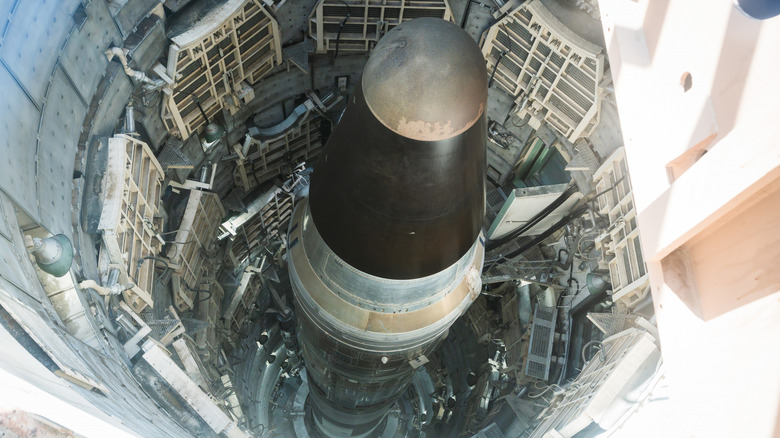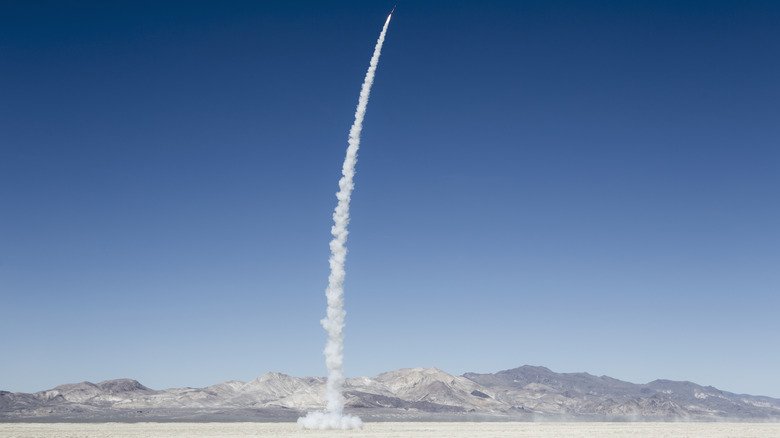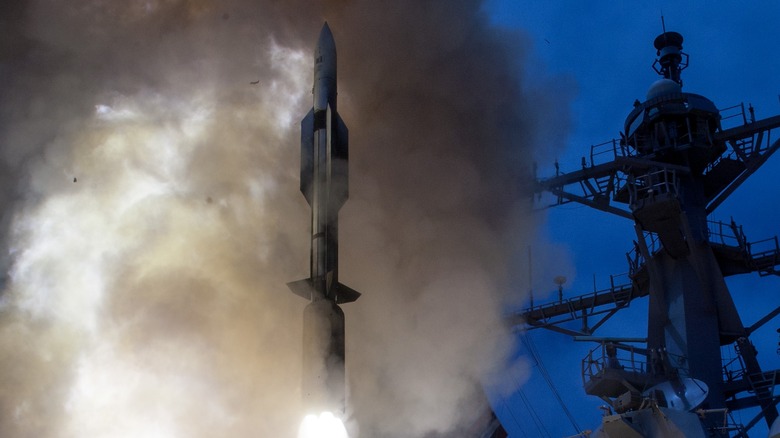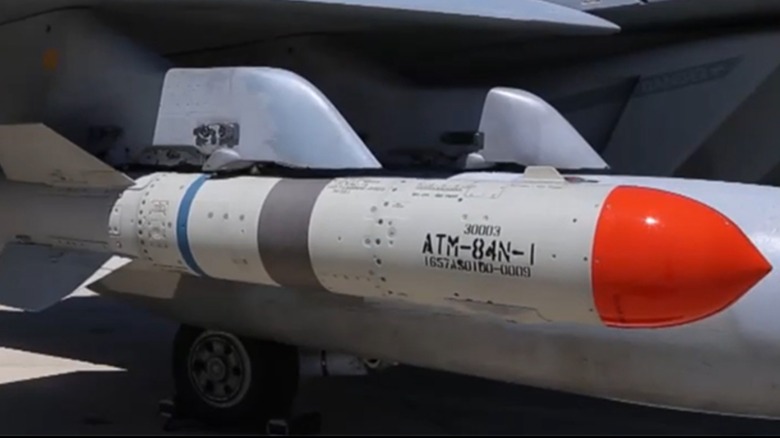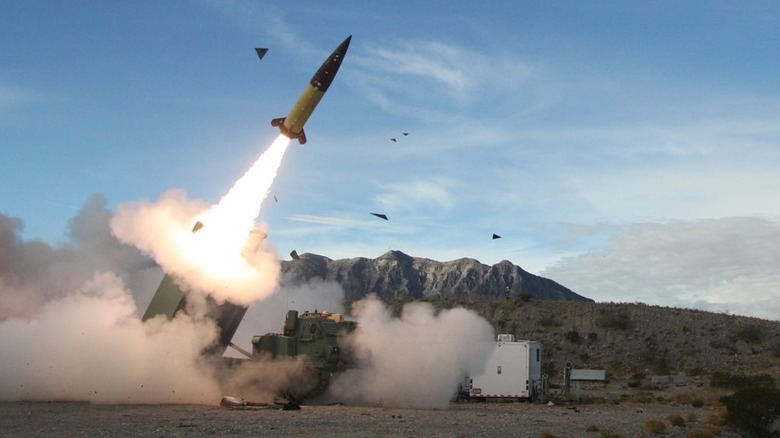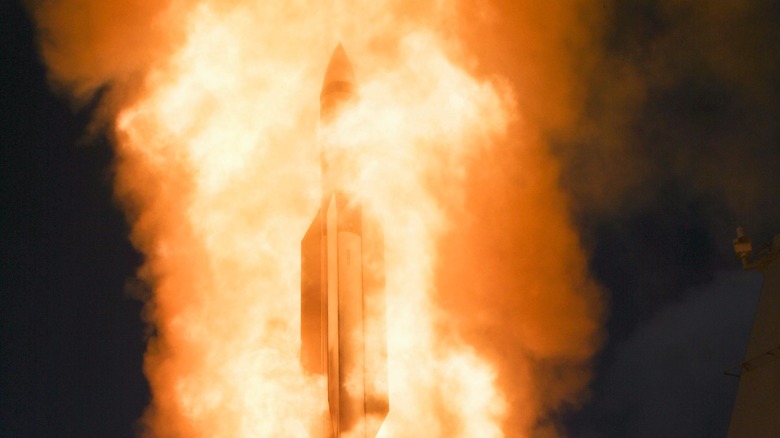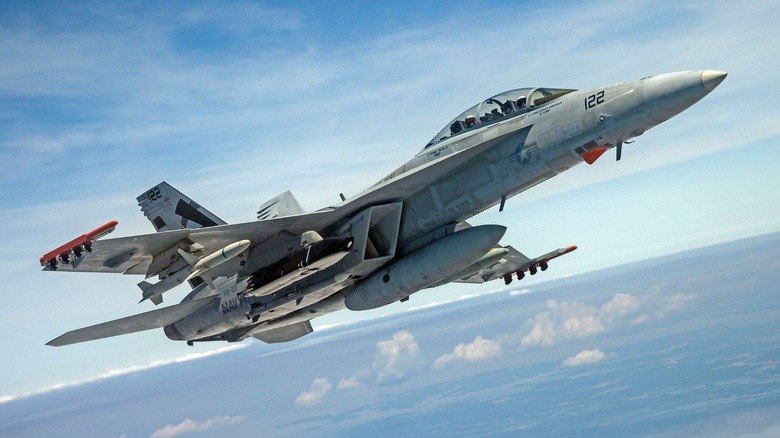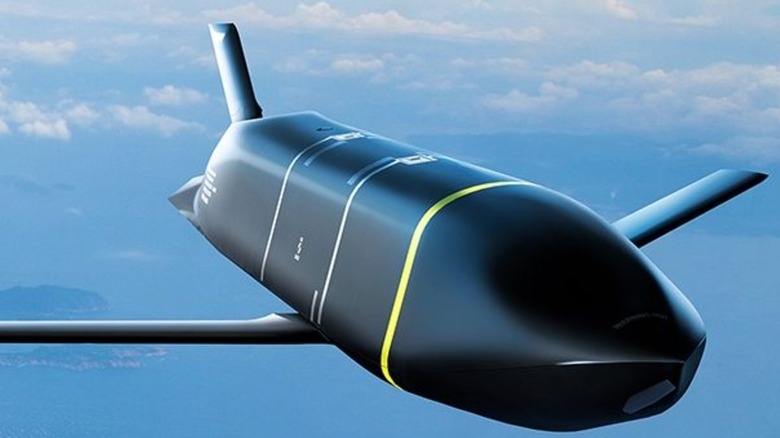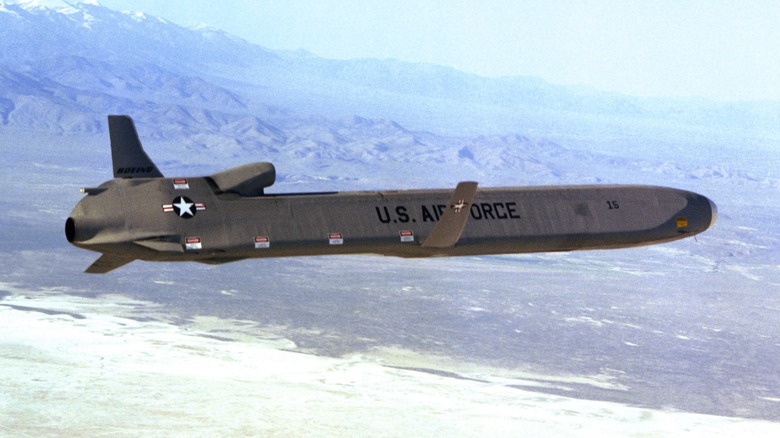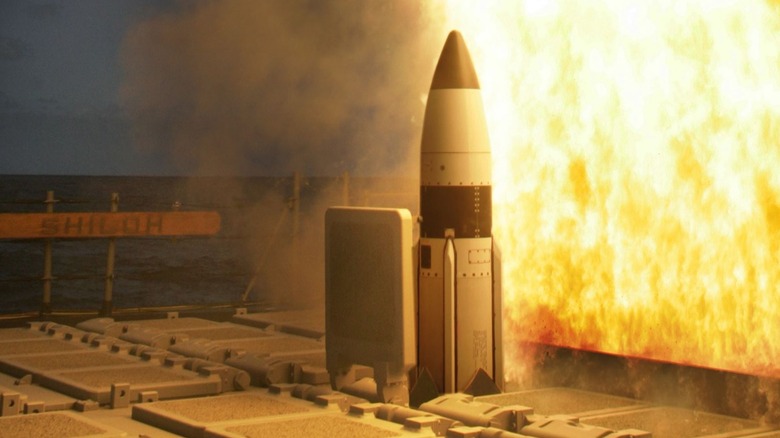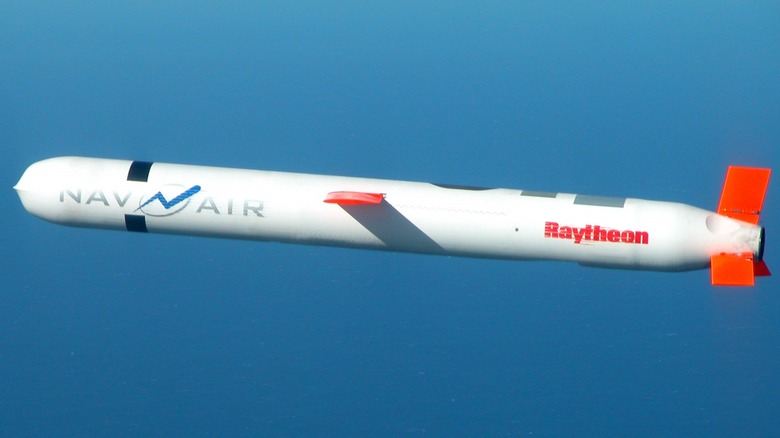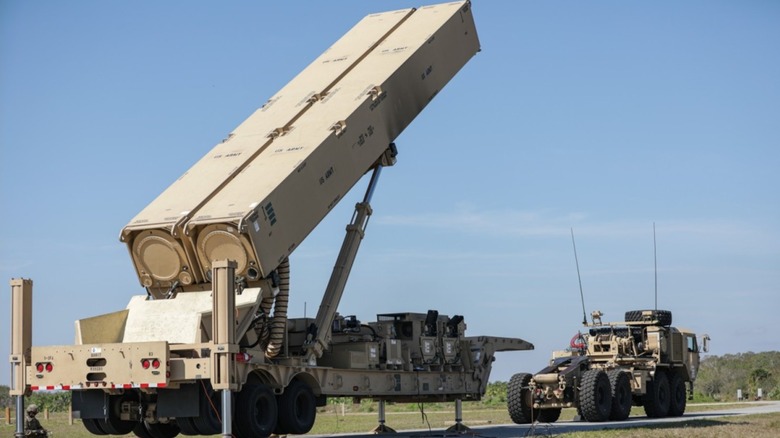13 Of The Longest-Range Operational Missiles In The US Military, Ranked
General Patton may have said, "Wars may be fought with weapons, but they are won by men," but that was before humanity started harnessing the power of the missile and turned it into a weapon of unimaginable power.
Missiles are a crucial part of any military's arsenal. Black Hawk helicopters can be equipped with them, and conversely, if a soldier wants to destroy a Black Hawk helicopter, they can shoot a missile at it. These self-propelled projectiles come in a variety of sizes and thus can be shot an equally varied number of distances. Generally speaking, the bigger the missile, the larger its range, but just what is the upper limit?
Missiles have become so mighty, we can launch them at enemies from other continents with frightening accuracy. Here are 13 of the longest-range missiles the United States military currently uses. Why just the United States? Because the U.S. spends more money on its military than any other country on the planet, and for the fiscal year of 2025, the U.S. government planned to have 40% of the money go towards missiles and missile-related systems. Let's just say that the U.S. military bets big on bombs and ballistics.
Difference Between a Missile and Rocket
Missiles are only one type of ammunition employed in military weapons, but they're so technologically advanced they're considered weapons themselves. While you would be hard pressed to mix up even the largest caliber of bullet with grenade rounds, we should get one thing straight: missiles and rockets are different.
To the untrained eye, they may look similar, if not downright identical. Both are explosives that soldiers can fire at distant targets, and both utilize rocket propulsion. However, just because something flies like a duck and explodes like a duck strapped to TNT, doesn't necessarily mean it is a duck.
The most obvious difference is accuracy. Once rockets are fired, they keep going until they hit something — be it their intended target or the ground. However, missiles can correct their trajectories and employ countermeasures against defences. As a result, they are more likely to hit their targets. Yes, bazookas (aka personal rocket launchers) are faster to shoot, but a Javelin Weapon System lets users duck for cover quicker without sacrificing accuracy. In terms of range and potential damage, however, missiles and rockets are basically tied.
13. RIM-174 Standard ERAM
While missiles aren't aircraft, they share the same naming conventions, classified via a string of letters and numbers. The first few letters indicate the missile's main mission and launch platform, and the last few state if it's a short-range or long-range missile.
The RIM-174 Standard Missile 6 ERAM is a guided missile designed to intercept aerial targets, including manned aircraft and missiles. Moreover, each missile is shot out of a vertical launch system on ships, hence the designation "RIM" — "R" is for "Ship-launched," "I" stands for "Intercept-aerial," and the "M" is short for "Guided missile." Raytheon has developed several variants of the RIM-174, including the RIM-174B with a built-in GPS and the AIM-174B which can be fired from fighter jets — the "A" stands for "Air-launched."
While certain RIM-174 specs are public knowledge (e.g., the missile carries a 140-pound blast-fragmentation warhead), its range is classified. However, reports state the RIM-174 can travel at least 150 miles, and some claim it can even reach up to 285 miles. That's where the "ERAM" part of the name comes into play, which stands for "Extended Range Active Missile." These ranges are in line with early reports that the missile was initially planned to hit targets 150 miles away, and that the range was later upgraded to "over 200 miles away."
12. AGM/RGM/UGM-84 Harpoon
While battleships can store heavy rounds bigger than crewmembers, their associated weapons can only hit what they see. If it's not visible and not on the radar, these oversized bullets won't hit anything. Some missiles, however, don't have such limitations.
Harpoon missiles, otherwise known as AGM/RGM/UGM-84 missiles, have been in use during the late 1970s — several coast guard ships were equipped with Harpoon missiles during the Cold War. These missiles can be launched in various weather conditions and from different platforms. Remember, the "R" in "RGM" and "A" in "AGM" stand for "Ship-launched" and "Air-launched," whereas the "U" in "UGM" means "Submarine-launched."
One of the Harpoon's most crucial features is its "over-the-horizon" capabilities, which means it can hone in on targets outside of radar and visual range. Understandably, the projectile couldn't perform this action unless it could travel further than most missiles, and this range varies between models . The AGM-84 Harpoon comes in last place with a still respectable 87 miles range, while the UGM-84 can travel up to 136 miles. However, the latest model, the RGM-84F, has a maximum range of 174 miles. This distance will likely increase with the next generation of Harpoon missiles.
11. AGM-88 HARM
In movies, TV shows, and games, a guided missile must lock onto a target before a pilot or soldier can let it loose. That's how the Javelin Weapon System works, but some long-range missiles are more fire-and-forget.
The Air-Force's AGM-88 missiles aren't called "HARM" just because some joker wanted to give them an edgy nickname. It's an acronym for "high-speed anti-radiation missile." These projectiles zero in on radar emissions. Technically, many guided missiles track radars, but Raytheon gave the HARM enough semi-autonomy to pick between targets, self-destruct to avoid friendly fire, and even home in on targets behind the launch platform. Currently, only F-16C fighter jets carry these missiles.
Raytheon has modified AGM-88 missiles over the years. Most of these changes implemented additional antennae or more powerful processors, but the HARM's range stayed the same – 93 miles – until the sixth generation. Dubbed AGM-88G (alternatively AARGM-ER) missiles, these weapons can fly up to 186 miles thanks to their improved propulsion systems. In November of 2024, the U.S. Air Force started testing the next HARM iteration, the AGM-88J. Only time will tell if it can fly further than the AGM-88G.
10. ATACMS
Another key difference between rockets and missiles is speed, or perhaps we should say potential speed. Missiles can exceed the speed of sound, which can be helpful when facing the myriad of anti-missile technologies and techniques out there.
The ATACMS, which stands for "Army Tactical Missile System", is a "conventional" missile and launching platform. Each ATACMS missile is guided via GPS and wields a 500-pound blast fragmentation warhead. Perhaps most important (and impressive) of all, the ATACMS is compatible with the High Mobility Artillery Rocket System (HIMARS) platform, as well as its less advanced predecessor, the MLRS M270.
While ATACMS missiles are classified as "short-range ballistic missiles," that name is a bit of a misnomer since they have a max range of 186 miles. That is nothing to sneeze at, but then again, any ballistic missile with a range shorter than 620 miles is considered "short-range." Moreover, ATACMS missiles have been clocked at hurtling over Mach 3 just before impact, which is not only impressive from a defensive standpoint since it's difficult to shoot down but because that speed increases the ATACMS' destructive capabilities. You can thank Isaac Newton for figuring that out.
9. RIM–156 Standard Missile 2
One big factor in a missile's design is its launch system. Is a missile stored and launched out of a silo, or is it part of a specialized device?
The Standard Missile 2, also known as the RIM-156, is one of the U.S. Navy's go-to surface-to air defense projectiles. This missile powers the AEGIS Weapon System (AWS) that makes the Arleigh Burke-class ship one of the most powerful naval destroyers in the world. Each RIM-156 is guided via IR sensors and a "semi-active radar" that can detect potential targets.
Currently, the RIM-156 comes in several varieties: the medium range Block III, Block IIIA, and Block IIIB missiles and the extended range Block IV missile. The Block III, IIIA, and IIIB models cap out at 104 miles, whereas the Block IV version can shoot up to 230 miles. While the RIM-156 Block IV sounds like an upgrade, the missile suffers from unstable programs, so the U.S. Navy is phasing it out in favor of the RIM-174. The RIM-174's range is shorter than that of the RIM-156, but you can't fault the Navy for prioritizing missiles with more reliable targeting systems.
8. AGM-158C LRASM
The farther a missile can travel, the more obvious a target it becomes. Unless, of course, it uses stealth technology, because you can't hit what you can't see — or detect on radar.
Lockheed Martin's AGM-158C Long Range Anti-Ship Missiles (LRASM) are precision projectiles carried and launched by fighter jets like the F/A-18 Hornet and Super Hornet. The LRASM's key feature is its stealth capabilities, which helps the missile survive long enough to hit targets with pinpoint accuracy. Of course, the exact mechanics behind this stealth tech are a highly guarded secret since if everybody knew, it wouldn't be very effective stealth. However, according to official documentation, we do know that the LRASM has an anti-jam GPS guidance system and designates targets via a combination of radio frequency and infrared sensors.
As with the stealth features, Lockheed Martin won't tell just anyone the LRASM's exact range. The weapon's "Fast Facts" page states the missile can travel over 230 miles, but the United States Naval Institute estimates its range is closer to 575 miles. Since the AGM-158C LRASM is a stealth missile, it's probably best we never learn its true range.
7. JASSM
Another important element in missile design is its warhead. These components are the proverbial tip of the spear — they carry all the explosive material. The greater the capacity and more destructive the material, the bigger the explosion. However, if a missile can't penetrate its target's armor, it might as well be carrying a thousand pounds of feathers.
The AGM 158 Joint Air-to-surface Stand-off Missile (JASSM) is another missile produced by Lockheed Martin and the basis for the LRASM. Both missiles share features such as the anti-jam GPS, but we failed to mention was the armor piercing capabilities. The JASSM — and LRASM — utilizes a 1,000-pound penetrator/blast fragmentation warhead that ensures as much of the explosion penetrates the target as possible.
Technically speaking, the U.S. Air Force uses two versions of the JASSM: the standard variety and the JASSM ER. Both are considered cruise missiles (which use aerodynamic lift to maintain altitude during flight). While the normal JASSM can fly for 230 miles, the JASSM ER has a maximum range of a 621 miles. In 2018, the Air Force began work on the latest JASSM model, the JASSM-XR — "XR" stands for "Extreme Range." According to official stats, this upgraded missile has a max range of 1,118 miles. That's longer than the state of California.
6. AGM-86 ALCM
What's the difference between a bomb and a missile? When you get right down to it, a bomb's explosive force is delivered via gravity, whereas missiles use a combination of rocket propulsion, gravity, and targeting systems. They're essentially bombs with a higher chance of hitting their targets that keep their users safer.
The AGM86 series of Air-Launched Cruise Missiles (ALCM) are novel ways to make bomber aircrafts more effective. Instead of ensuring these planes are resistant to anti-aircraft weapons while dropping their payloads, ALCMs are designed to be launched outside of anti-aircraft battery range. Moreover, because bombers can store so many ALCMs, they can fire these weapons en masse to overwhelm potential targets. Defensive batteries can shoot some down, but can they shoot all the ALCMs down?
Technically, the U.S. Air Force doesn't use AGM-86 ALCM missiles anymore. Sort of. In 2019, the military officially retired AGM-86C and D models, which carry conventional blast-class warheads, but the Air Force maintains a stockpile of AGM-86B missiles, which are equipped with nuclear warheads. Moreover, AGM-86Bs have the longest range of any ALCM, topping out at 1,553 miles. This reserve of nuclear missiles won't officially retire until 2030.
5. RIM-161 Standard Missile 3
As with all military aircraft, every missile is designed with a specific purpose. For instance, China's hypersonic missile is designed to strike almost any target in the world in a matter of minutes. However, sometimes missiles can also serve other purposes, with enough fuel.
Raytheon's RIM-161 Standard Missile 3 is based on the RIM-156 Standard Missile 2, specifically the ER version. In fact, the RIM-161 uses the RIM-156 ER's base frame and propulsion system but adds an updated GPS unit and a Lightweight Exo-Atmosphere Projectile (LEAP) warhead. Oh, and a third stage rocket motor for extended flight range. These components let the Standard Missile 3 hit anything from ballistic missiles to satellites in low orbit.
Like the RIM-156, the RIM-161 comes in several flavors. These include the RIM-161A, B, C, and D. Most of the upgrades include components such as threat discrimination software, but some alterations also impact the missile's potential distance. It is estimated that the first three variants, RIM-161A through C, can travel up to 7435 miles, whereas the RIM-161D caps out at a whopping 1,553 miles. Because of their extended range, only the RIM-161D missiles can hit satellites.
4. Tomahawk Missile
Like military vehicles, most if not all missiles belong to "families." Engineers start with a base model and modify it to meet specific metrics. Even when a missile is tweaked to fly farther than similar models, it is still part of the same family.
If you know anything about missiles, odds are you've heard of the Tomahawk missile. These weapons entered the public eye in 1991, and since then, the Tomahawk has been a key instrument in every major conflict the U.S. participated in. This is due to the missile's versatility; soldiers can fire Tomahawk missiles from ships, submarines, and ground platforms. Engineers have had plenty of time to update the weapon. Modern iterations are even capable of "loitering over a target area in order to respond to emerging targets."
While Tomahawk missiles can be fired from a variety of platforms, they are primarily used on ships and submarines, so they need impressive ranges to hit landlocked targets. Depending on the model, a Tomahawk missile can fly anywhere between 776 miles and 1,553 miles. This range is doubly impressive since the missiles are designed to navigate at low altitudes.
3. LRHW
So far, most of the missiles we've discussed have been around for decades. Of course, the U.S. military is always trying to up its game with new weapons.
The Long-Range Hypersonic Weapon (LRHW), aka Dark Eagle, is one of the latest additions to the U.S. military's toolbelt. Each LRHW consists of a missile battery, the actual LRHW missile, and a "hypersonic glide body" attached to said missile. According to Lockheed Martin, LRHW projectiles can travel as fast at Mach 5, which while impressive isn't quite as fast as the Mach 8 achieved by the world's fastest hypersonic missile, Russia's 3M22 Zircon.
According to reports, LRHW missiles have an estimated range of 1,725 miles. This feat is accomplished by the hypersonic glide body, which reportedly uses a booster rocket motor to accelerate then discards the booster unit when empty. Despite rocketing the missile at over 3,806 miles per hour, the glide body is planned to be highly maneuverable to make the speedy projectile that much harder to intercept. Initially, the Navy planned to install LRHW batteries onboard Zumwalt-class destroyers, but since the military canceled that project, the LRHW will find a home on other vessels.
2. UGM-133 Trident II
Submarines need to remain submerged to remain effective, so most of their armaments have to function underwater. One of the only exceptions are missiles, which can be fired above or below the surface and can generally strike almost anywhere. And not just because submarines can pop up almost anywhere.
The UGM-133 Trident II, also known as the Trident D5, is the successor to the original Trident missile. Both weapons are stored in the nuclear-powered Ohio-class submarines. As you might expect, the Trident II is more accurate, has a longer range, and carries more fissible material than the original Trident. Each Trident missile is classified as a low-yield nuclear weapon and is thus considered a deterrent.
Since Trident II missiles cram the power of the atom into warheads that can unleash anywhere between 100 to 475 kilotons of explosive force, they need ranges to match. The minimum safe firing distance is 1,243 miles, but they can reach a maximum of 7,500 miles. For the sake of comparison, the Atlantic Ocean is anywhere between 1,770 miles and 3,000 miles wide depending on where you measure. Meanwhile, the Trident 1 missile capped out at 4,600 miles.
1. LGM-30 Minuteman III
When most people hear the word "missile," they probably imagine an intercontinental ballistic missile (ICBM). Not surprising since these are the largest, most destructive missiles ever devised, literally monuments to humanity's destructive capabilities. And of course, when a missile is that big, it has fuel and range to spare.
Technically speaking, the Trident II missile is considered an ICBM, but that weapon has nothing on the LGM-30 Minuteman III. This titanic projectile is the latest version of the Minuteman missile, which entered service in 1962. Currently, the Minuteman III is the United States' only land-based ICBM. At 79,432 pounds and carrying enough fissible material to deliver up to 475 kilotons of explosive force, the Minuteman III is a behemoth in more ways than one.
While Trident II missiles weigh more than Minuteman III missiles, Minuteman III missiles have their submarine-based brethren beat in terms of distance, if only slightly. Minuteman III missiles have a maximum range of 8,077 miles. Currently, the weapons are stored in Air Force bases across the United States, which means they can quickly strike almost anywhere on the planet if it came down to it. Let's hope it never does.
